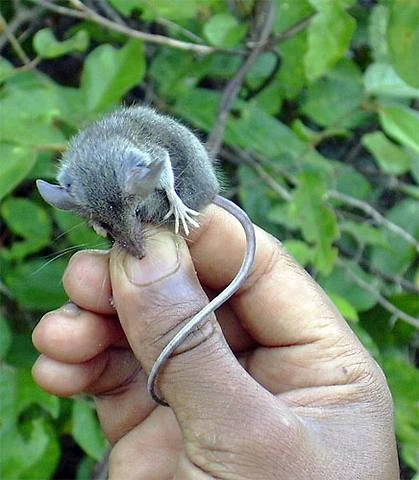If you cannot find the answer you are looking for, please contact us.
Jenkins’s shrew tenrec

First described in 2004 by Goodman & Soarimalala, Jenkins’s Shrew Tenrec is unique among its relatives for having a tail that is noticeably longer than its body.
Taxonomy
| Kingdom: | Animalia |
| Phylum: | Chordata |
| Class: | Mammalia |
| Order: | Afrosoricida |
| Suborder: | Tenrecomorpha |
| Family: | Tenrecidae |
| Genus: | Microgale |
| Species: | Microgale jenkinsae |
Natural range & habitat
Jenkins’s Shrew Tenrec is known only from very dry forest and shrubland in the Mikea Forest of southwestern Madagascar, in a small area approximately between Morombe and Manombo River. It inhabits sandy soil woodlands where rainfall ranges from about 350 to 750 mm annually, with a short canopy dominated by dry vegetation species. Its known range is extremely limited, estimated at around 1.6 km², and subsequent surveys in similar habitats have not yet recorded additional individuals.
Physical traits
This tiny mammal measures only about 143–147 mm in total length, the tail alone accounting for 71–81 mm, making it longer than the body itself. Individuals weigh between roughly 5 and 5.5 g. Its fur is dense and tannish-brown with darker flecks, giving an agouti appearance, while the underside is paler and slate-grey. The tail is dark above and much lighter below. Overall, its proportions and fur pattern distinguish it from other shrew tenrecs.
Behavior & lifestyle
Almost nothing is known about the behavior of Jenkins’s Shrew Tenrec due to its rarity. It is presumed to be terrestrial and ground-dwelling, likely moving silently through leaf litter or shallow sandy soils. The two known individuals were caught during the rainy season and were not fully grown, suggesting reproductive activity may align with wetter months. Social behavior, activity rhythm, nesting or burrowing habits remain undocumented.
Communication
No specific observations exist regarding communication. It is likely that, as with other shrew tenrecs, it uses scent marking and possibly tactile cues in brief social interactions, but no vocalizations or chemical signalling have been recorded.
Diet in the wild
Because no dietary studies exist, diet can only be inferred from related species and morphology: insectivorous prey such as worms and small arthropods found in the leaf litter or soil are likely. Its small size and high metabolism suggest frequent foraging, though no direct evidence confirms this.
Reproduction & life cycle
Virtually nothing is known about its reproduction. At the time of capture, the two individuals were juvenile or sub‑adult. Litter size, gestation, seasonal timing and development remain entirely speculative, though reproduction during the rainy season seems plausible given the context of collection.
Threats & conservation status
This species is classified as Endangered by the IUCN due to its extremely limited known range (less than ~2,000 km²), occurrence at only one site, and ongoing habitat loss in the Mikea Forest region. Forest clearance for agriculture, bushfires and vegetation degradation are key threats. Although the Mikea Forest is in the process of becoming a protected area, urgent research and habitat monitoring are needed to assess its true status and potential adaptability to disturbance.
This species in captivity
There are no records of Jenkins’s Shrew Tenrec ever being kept or bred in captivity. No zoo collections or private institutions report holding this species, and no husbandry information exists.
